Applied Mathematics and Mechanics (English Edition) ›› 2025, Vol. 46 ›› Issue (6): 989-1010.doi: https://doi.org/10.1007/s10483-025-3264-7
Tingting CHEN1,2, Kai WANG1,2,†( ), Shengchao CHEN1,2, Ziyu XU1,2, Zhe LI1,2, Jiaxi ZHOU1,2
), Shengchao CHEN1,2, Ziyu XU1,2, Zhe LI1,2, Jiaxi ZHOU1,2
Received:2025-02-23
Revised:2025-04-25
Published:2025-06-05
Contact:
Kai WANG, E-mail: wangkai@hnu.edu.cnSupported by:2010 MSC Number:
Tingting CHEN, Kai WANG, Shengchao CHEN, Ziyu XU, Zhe LI, Jiaxi ZHOU. Nonlinear electromechanical coupling dynamics of a two-degree-of-freedom hybrid energy harvester. Applied Mathematics and Mechanics (English Edition), 2025, 46(6): 989-1010.
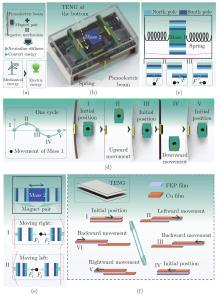
Fig. 1
Fundamental configuration and operational principles of the energy harvester: (a) low stiffness and energy harvesting concept using PCBs; (b) three-dimensional (3D) model of the energy harvester; (c) the computational model of Mass 1; (d) the motion sequence of the piezoelectric energy conversion unit over one operational cycle; (e) the computational model of Mass 2; (f) the motion mechanism of the TENG unit (color online)"

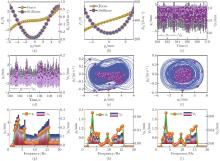
Fig. 3
The restoring force and stiffness of (a) the first layer and (b) the second layer energy harvesters calculated by the dynamic data; (c) the phase portraits and Poincare sections corresponding to the motion of Mass 1; (d) the comparison of the time series depicting the motion displacement of Mass 1 and the mid-span deflection response of the PCB; (e) the comparison of the time series depicting the motion displacement of Mass 2 and the mid-span deflection response of the PCB; (f) the phase portraits and Poincare sections corresponding to the motion of Mass 2; (g)–(i) the amplitude-frequency response curves for the mass and mid-span deflection of the PCBs (color online)"

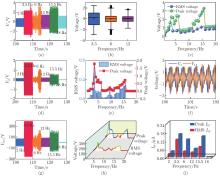
Fig. 4
(a) Time series of voltage responses for PCB 1 under varying excitation frequencies; (b) data distribution of the output voltage for the PCB in the first layer; (c) comparison of the RMS and peak voltage of the PCB in the first layer; (d) time series of voltage responses for the PCB 3 under varying excitation frequencies; (e) comparison of the RMS and peak voltages of the PCB in the second layer; (f) comparison of the output voltage for the PCB 3 and PCB 4; (g) time series of voltage responses for the TENG under varying excitation frequencies; (h) RMS and peak output voltages of the TENG; (i) RMS and peak SC current of the TENG under different excitation frequencies (color online)"

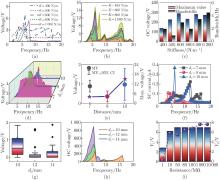
Fig. 5
Effects of system parameters on electrical outputs: (a) output voltage of PCB 1; (b) PCB 3 as a function of the stiffness; (c) OC voltage of the TENG as a function of the stiffness; (d)–(f) electrical outputs of the energy harvester as a function of the distance between the first magnet pair; (g)–(h) electrical outputs as a function of the distance between the second layer magnet pair; (i) output voltage of the first and second layer PCBs as a function of external resistance (color online)"

| [1] | ZHAO, Y., YANG, F., JIANG, H., and GAO, G. Piezoceramic membrane with built-in ultrasound for reactive oxygen species generation and synergistic vibration anti-fouling. Nature Communications, 15, 4845 (2024) |
| [2] | YAN, B., YU, N., and WU, C. A state-of-the-art review on low-frequency nonlinear vibration isolation with electromagnetic mechanisms. Applied Mathematics and Mechanics (English Edition), 43(7), 1045-1062 (2022) https://doi.org/10.1007/s10483-022-2868-5 |
| [3] | DING, H. and JI, J. C. Vibration control of fluid-conveying pipes: a state-of-the-art review. Applied Mathematics and Mechanics (English Edition), 44(9), 1423-1456 (2023) https://doi.org/10.1007/s10483-023-3023-9 |
| [4] | WANG, K., ZHOU, J., TAN, D., LI, Z., LIN, Q., and XU, D. A brief review of metamaterials for opening low-frequency band gaps. Applied Mathematics and Mechanics (English Edition), 43(7), 1125-1144 (2022) https://doi.org/10.1007/s10483-022-2870-9 |
| [5] | JOHNSON-LOVE, O., SALMERON-SANCHEZ, M., REID, S., CHILDS, P. G., and DALBY, M. J. Vibration-based cell engineering. Nature Reviews Bioengineering (2025) https://doi.org/10.1038/s44222-025-00273-x |
| [6] | HAGIWARA, Y., HASEBE, S., FUJISAWA, H., MORIKAWA, J., ASAHI, T., and KOSHIMA, H. Photothermally induced natural vibration for versatile and high-speed actuation of crystals. Nature Communications, 14, 1354 (2023) |
| [7] | CHEN, Z., XU, X., PAN, M., DENG, H., CAO, Y., ZHAO, S., ZHOU, E., and DUAN, C. Effect of vibration and airflow on separation of 6-1 mm fine coal in compound dry separation bed. Chemical Engineering Research and Design, 207, 350-360 (2024) |
| [8] | LI, X., ZHENG, J., LI, Y., XIAO, J., GUO, B., and LIU, C. Modeling and experimental investigation of drilling force for low-frequency axial vibration-assisted BTA deep hole drilling. The International Journal of Advanced Manufacturing Technology, 111, 1721-1733 (2020) |
| [9] | TAN, D., WANG, K., ZHOU, J., PENG, J., and WANG, Q. A brief review of nonlinear triboelectric nanogenerator. International Journal of Dynamics and Control, 12, 2072-2092 (2024) |
| [10] | ZHANG, B., LIU, H., ZHOU, S., and GAO, J. A review of nonlinear piezoelectric energy harvesting interface circuits in discrete components. Applied Mathematics and Mechanics (English Edition), 43(7), 1001-1026 (2022) https://doi.org/10.1007/s10483-022-2863-6 |
| [11] | YANG, J., ZHANG, W., and YANG, X. Integrated device for multiscale series vibration reduction and energy harvesting. Applied Mathematics and Mechanics (English Edition), 44(12), 2227-2242 (2023) https://doi.org/10.1007/s10483-023-3063-8 |
| [12] | LU, K., HU, R., WANG, X., and DENG, Z. Multi-directional and ultra-low frequency energy harvester utilizing tunable buckled piezoelectric film. Mechanical Systems and Signal Processing, 210, 111137 (2024) |
| [13] | MENG, Y., LU, Z. Q., DING, H., and CHEN, L. Q. Plate theory based modeling and analysis of nonlinear piezoelectric composite circular plate energy harvesters. Nonlinear Dynamics, 112, 5129-5149 (2024) |
| [14] | HAN, M., WANG, H., YANG, Y., LIANG, C., BAI, W., YAN, Z., LI, H., XUE, Y., WANG, X., AKAR, B., ZHAO, H., LUAN, H., LIM, J., KANDELA, I., AMEER, G. A., ZHANG, Y., HUANG, Y., and ROGERS, J. A. Three-dimensional piezoelectric polymer microsystems for vibrational energy harvesting, robotic interfaces and biomedical implants. Nature Electronics, 2, 26-35 (2019) |
| [15] | GAO, Z., FANG, C., GAO, Y., YIN, X., ZHANG, S., LU, J., WU, G., WU, H., and XU, B. Hybrid electromagnetic and moisture energy harvesting enabled by ionic diode films. Nature Communications, 16, 312 (2025) |
| [16] | ZHAO, L., LU, Z., DING, H., and CHEN, L. Q. A viscoelastic metamaterial beam for integrated vibration isolation and energy harvesting. Applied Mathematics and Mechanics (English Edition), 45(7), 1243-1260 (2024) https://doi.org/10.1007/s10483-024-3159-7 |
| [17] | LU, Z. Q., ZHAO, L., FU, H. L., YEATMAN, E., DING, H., and CHEN, L. Q. Ocean wave energy harvesting with high energy density and self-powered monitoring system. Nature Communications, 15, 6513 (2024) |
| [18] | LU, W., FU, J., WU, N., and HE, Y. Fatigue in vibration energy harvesters: state-of-the-art review. Renewable and Sustainable Energy Reviews, 214, 115521 (2025) |
| [19] | WANG, K., ZHOU, J., OUYANG, H., CHANG, Y., and XU, D. A dual quasi-zero-stiffness sliding-mode triboelectric nanogenerator for harvesting ultralow-low frequency vibration energy. Mechanical Systems and Signal Processing, 151, 107368 (2021) |
| [20] | CHEN, B. D., TANG, W., HE, C., DENG, C. R., YANG, L. J., ZHU, L. P., CHEN, J., SHAO, J. J., LIU, L., and WANG, Z. L. Water wave energy harvesting and self-powered liquid-surface fluctuation sensing based on bionic-jellyfish triboelectric nanogenerator. Materials Today, 21, 88-97 (2018) |
| [21] | FANG, S., ZHOU, S., YURCHENKO, D., YANG, T., and LIAO, W. H. Multistability phenomenon in signal processing, energy harvesting, composite structures, and metamaterials: a review. Mechanical Systems and Signal Processing, 166, 108419 (2022) |
| [22] | WANG, R., TANG, E., YANG, G., HAN, Y., and CHEN, C. Dynamic fracture behavior of piezoelectric ceramics under impact: force-electric response and electrical breakdown. Journal of the European Ceramic Society, 41, 139-150 (2021) |
| [23] | YU, N., MA, H., WU, C., YU, G., and YAN, B. Modeling and experimental investigation of a novel bistable two-degree-of-freedom electromagnetic energy harvester. Mechanical Systems and Signal Processing, 156, 107608 (2021) |
| [24] | XU, X., WU, Q., PANG, Y., CAO, Y., FANG, Y., HUANG, G., and CAO, C. Multifunctional metamaterials for energy harvesting and vibration control. Advanced Functional Materials, 32, 2107896 (2022) |
| [25] | MARGIELEWICZ, J., GASKA, D., LITAK, G., WOLSZCZAK, P., and ZHOU, S. Energy harvesting in a system with a two-stage flexible cantilever beam. Sensors, 22, 7399 (2022) |
| [26] | ZHENG, H., WANG, Y., LIU, J., WANG, J., YAN, K., and ZHU, K. Recent advancements in the use of novel piezoelectric materials for piezocatalytic and piezo-photocatalytic applications. Applied Catalysis B: Environmental, 341, 125335 (2024) |
| [27] | LIANG, H., HAO, G., and OLSZEWSKI, O. Z. A review on vibration-based piezoelectric energy harvesting from the aspect of compliant mechanisms. Sensors and Actuators A: Physical, 331, 112743 (2021) |
| [28] | WANG, T., ZHANG, Q., HAN, J., TIAN, R., YAN, Y., CAO, X., and HAO, S. Low-frequency energy scavenging by a stacked tri-stable piezoelectric energy harvester. International Journal of Mechanical Sciences, 280, 109546 (2024) |
| [29] | FU, H., JIANG, J., HU, S., RAO, J., and THEODOSSIADES, S. A multi-stable ultra-low frequency energy harvester using a nonlinear pendulum and piezoelectric transduction for self-powered sensing. Mechanical Systems and Signal Processing, 189, 110034 (2023) |
| [30] | LI, H. T., DONG, B. J., CAO, F., QIN, W. Y,, DING, H., and CHEN, L. Q. Nonlinear dynamical and harvesting characteristics of bistable energy harvester under hybrid base vibration and galloping. Communications in Nonlinear Science and Numerical Simulation, 125, 107400 (2023) |
| [31] | ZHANG, P., LI, X., and WANG, J. Nonlinear effect on stable state and snap-through bistability of square composite laminate. European Journal of Mechanics A/Solids, 109, 105431 (2025) |
| [32] | SHI, G., PENG, Y., TONG, D., CHANG, J., LI, Q., WANG, X., XIA, H., and YE, Y. An ultra-low frequency vibration energy harvester with zigzag piezoelectric spring actuated by rolling ball. Energy Conversion and Management, 243, 114439 (2021) |
| [33] | CAO, D. X., ZHAN, C. H., GUO, X. Y., and YAO, M. H. An impact-driven enhanced tuning fork for low-frequency ambient vibration energy harvesting: modeling, simulation, and experiment. Journal of Vibration Engineering and Technologies, 12, 5073-5088 (2024) |
| [34] | WU, Y., LI, S., FAN, K., JI, H., and QIU, J. Investigation of an ultra-low frequency piezoelectric energy harvester with high frequency up-conversion factor caused by internal resonance mechanism. Mechanical Systems and Signal Processing, 162, 108038 (2022) |
| [35] | THULASI, V., LAKSHMI, P., SAMUEL, E. J. J., and ROOPAN, S. M. Fabrication of ferrite nanoparticle based improved composite piezoelectric energy harvester for biomechanical energy conversion. Materials Science and Engineering: B, 313, 117915 (2025) |
| [36] | CHEN, T., WANG, K., CHENG, L., PAN, H., CUI, H., and ZHOU, J. Theoretical and experimental research on a quasi-zero-stiffness-enabled nonlinear piezoelectric energy harvester. Communications in Nonlinear Science and Numerical Simulation, 133, 107863 (2024) |
| [37] | CHEN, T., WANG, K., WANG, Q., WANG, Y., CHENG, L., and ZHOU, J. A chinese lantern-inspired low frequency energy harvester with synchronized multi-branched conversion elements. Engineering Structures, 334, 120266 (2025) |
| [38] | CAO, D., WANG, J., GUO, X., LAI, S. K., and SHEN, Y. Recent advancement of flow-induced piezoelectric vibration energy harvesting techniques: principles, structures, and nonlinear designs. Applied Mathematics and Mechanics (English Edition), 43(7), 959-978 (2022) https://doi.org/10.1007/s10483-022-2809-7 |
| [39] | FANG, S., MIAO, G., CHEN, K., XING, J., ZHOU, S., YANG, Z., and LIAO, W. H. Broadband energy harvester for low-frequency rotations utilizing centrifugal softening piezoelectric beam array. Energy, 241, 122833 (2022) |
| [40] | PERTIN, O., GUHA, K., JAKŠIĆ, O., JAKŠIĆ, Z., and IANNACCI, J. Investigation of nonlinear piezoelectric energy harvester for low-frequency and wideband applications. Micromachines, 13, 1399 (2022) |
| [41] | WANG, K., OUYANG, H., ZHOU, J., CHANG, Y., XU, D., and ZHAO, H. A nonlinear hybrid energy harvester with high ultralow-frequency energy harvesting performance. Meccanica, 56, 461-480 (2021) |
| [42] | HE, L., LIU, R., LIU, X., ZHENG, X., ZHANG, L., and LIN, J. A piezoelectric-electromagnetic hybrid energy harvester for low-frequency wave motion and self-sensing wave environment monitoring. Energy Conversion and Management, 300, 117920 (2024) |
| [43] | JIAO, P., EGBE, K. J. I., NAZAR, A. M., YANG, Y., and WANG, H. Oscillatory magnetic piezoelectric nanogenerators under low-frequency and low-amplitude excitations. Sustainable Energy Technologies and Assessments, 52, 102022 (2022) |
| [44] | ZI, Y., LIN, L., WANG, J., WANG, S., CHEN, J., FAN, X., YANG, P. K., YI, F., and WANG, Z. L. Triboelectric-pyroelectric-piezoelectric hybrid cell for high-efficiency energy-harvesting and self-powered sensing. Advanced Materials, 27, 2340-2347 (2015) |
| [45] | ZHU, Y., ZHANG, B., DU, K., CHEN, Z., ZHAO, L., WEI, K., ZHANG, W., YANG, W., and ZOU, H. High-power biomechanical energy harvesting from all limb movements of humans. IEEE/ASME Transactions on Mechatronics (2024) https://doi.org/10.1009/TMECH.2024.3502660 |
| [46] | TAN, D., ZHOU, J., WANG, K., CAI, C., and XU, D. Modeling and analysis of the friction in a non-linear sliding-mode triboelectric energy harvester. Acta Mechanica Sinica, 38, 521330 (2022) |
| [47] | NIU, S., LIU, Y., WANG, S., LIN, L., ZHOU, Y. S., HU, Y., and WANG, Z. L. Theory of sliding-mode triboelectric nanogenerators. Advanced Materials, 25, 6184-6193 (2013) |
| [1] | Tianchi YU, Feng LIANG, Hualin YANG. Vibration energy harvesting of a three-directional functionally graded pipe conveying fluids [J]. Applied Mathematics and Mechanics (English Edition), 2025, 46(5): 795-812. |
| [2] | Youcheng ZENG, Hu DING, J. C. JI. An origami-inspired nonlinear energy sink: design, modeling, and analysis [J]. Applied Mathematics and Mechanics (English Edition), 2025, 46(4): 601-616. |
| [3] | Jiamei WANG, Siukai LAI, Chen WANG, Yiting ZHANG, Zhaolin CHEN. On the role of sliding friction effect in nonlinear tri-hybrid vibration-based energy harvesting [J]. Applied Mathematics and Mechanics (English Edition), 2024, 45(8): 1295-1314. |
| [4] | Xinyu LIAN, Bing LIU, Huaxia DENG, Xinglong GONG. A vibration isolator with a controllable quasi-zero stiffness region based on nonlinear force design [J]. Applied Mathematics and Mechanics (English Edition), 2024, 45(8): 1279-1294. |
| [5] | Long ZHAO, Zeqi LU, Hu DING, Liqun CHEN. A viscoelastic metamaterial beam for integrated vibration isolation and energy harvesting [J]. Applied Mathematics and Mechanics (English Edition), 2024, 45(7): 1243-1260. |
| [6] | Jiahao ZHOU, Jiaxi ZHOU, Hongbin PAN, Kai WANG, Changqi CAI, Guilin WEN. Multi-layer quasi-zero-stiffness meta-structure for high-efficiency vibration isolation at low frequency [J]. Applied Mathematics and Mechanics (English Edition), 2024, 45(7): 1189-1208. |
| [7] | Lanbin ZHANG, Yixiang HE, Bo MENG, Huliang DAI, Lin WANG. Unlocking multidirectional and broadband wind energy harvesting with triboelectric nanogenerator and vortex-induced vibration of sphere [J]. Applied Mathematics and Mechanics (English Edition), 2024, 45(11): 1895-1912. |
| [8] | Qingqing LIU, Shenlong WANG, Ge YAN, Hu DING, Haihua WANG, Qiang SHI, Xiaohong DING, Huijie YU. A human-sensitive frequency band vibration isolator for heavy-duty truck seats [J]. Applied Mathematics and Mechanics (English Edition), 2024, 45(10): 1733-1748. |
| [9] | Yang JIN, Tianzhi YANG. Enhanced vibration suppression and energy harvesting in fluid-conveying pipes [J]. Applied Mathematics and Mechanics (English Edition), 2023, 44(9): 1487-1496. |
| [10] | Jihou YANG, Weixing ZHANG, Xiaodong YANG. Integrated device for multiscale series vibration reduction and energy harvesting [J]. Applied Mathematics and Mechanics (English Edition), 2023, 44(12): 2227-2242. |
| [11] | Wenzheng QUE, Xiaodong YANG, Wei ZHANG. Tunable low frequency band gaps and sound transmission loss of a lever-type metamaterial plate [J]. Applied Mathematics and Mechanics (English Edition), 2022, 43(8): 1145-1158. |
| [12] | Xiaoye MAO, Mengmeng YIN, Hu DING, Xiaofeng GENG, Yongjun SHEN, Liqun CHEN. Modeling, analysis, and simulation of X-shape quasi-zero-stiffness-roller vibration isolators [J]. Applied Mathematics and Mechanics (English Edition), 2022, 43(7): 1027-1044. |
| [13] | Bin ZHANG, Hongsheng LIU, Shengxi ZHOU, Jun GAO. A review of nonlinear piezoelectric energy harvesting interface circuits in discrete components [J]. Applied Mathematics and Mechanics (English Edition), 2022, 43(7): 1001-1026. |
| [14] | Dongxing CAO, Junru WANG, Xiangying GUO, S. K. LAI, Yongjun SHEN. Recent advancement of flow-induced piezoelectric vibration energy harvesting techniques: principles, structures, and nonlinear designs [J]. Applied Mathematics and Mechanics (English Edition), 2022, 43(7): 959-978. |
| [15] | Qiong WANG, Zewen CHEN, Linchuan ZHAO, Meng LI, Hongxiang ZOU, Kexiang WEI, Xizheng ZHANG, Wenming ZHANG. Enhanced galloping energy harvester with cooperative mode of vibration and collision [J]. Applied Mathematics and Mechanics (English Edition), 2022, 43(7): 945-958. |
| Viewed | ||||||
|
Full text |
|
|||||
|
Abstract |
|
|||||

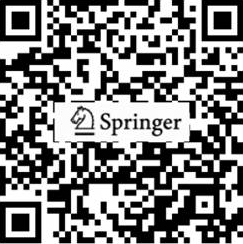
 Email Alert
Email Alert RSS
RSS